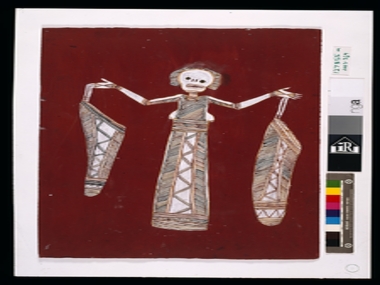LOFTY - WAMUD NAMOK

Wakkewakken Honey Spirit III 2003. Natural pigments on paper 75x26 cms. Collection NAG
Posted by Jeremy Eccles | 13.12.10
Gallery: Museum of Contemporary Art
Dates:
10.12.00
: 20.03.00
The life and work of the great Bardayal 'Lofty' Nadjamerrek is being celebrated this summer at the Museum of Contemporary Art in Sydney. One immediate challenge to the mind is to wonder how the man known as “the last of the rock art painters”, living remotely on the Mann River escarpment of Western Arnhemland until he died last October aged about 83, can in any meaningful sense be a 'contemporary' artist?
Certainly he was painting now until just before his death. He has also ensured continuity for his particular style of single-hatched rarrking by establishing a training program for his grandchildren. And the MCA has a splendid mural created by them as proof of his achievement. For Lofty always believed that the cross-hatched rarrking by which younger artists and his neighbouring confreres like John Mawurdndjul achieved a mesmeric shine to their barks took them dangerously close to revealing secret/sacred aspects of his culture.
But his artistic heart lay in the distant past – perhaps 12,000 years ago when the seas flowed over the Arafura Plains at the end of an Ice Age, forcing residents there southwards to fight for the land across northern Australia inhabited by an earlier group of migrants. Cave art on Lofty's Mok Estate clearly shows that battles were fought and a new style of art won the day – X-ray images of animals replacing more gracile, more human representations. Intriguingly, in his last etching series, Lofty introduced some of those human figures, which he'd previously declared had been the work of mimihs, teaching art to his people before disappearing into the rocks.
Most of Lofty's work on show, therefore is of kangaroos, echidnas, emus, barramundi and an infinite variety of Ngalyods or Rainbow Serpents in a style that is consistent from his earliest work in 1959, and remains wholly his own. There's always movement in his subjects – even when he's capturing the indefinable character of the Wakkewakken Honey Spirits who motivate his Ankung Klang, or Dreaming, or tackling ceremonial events such as the Uburr or Mardayin ceremonies, where the superficial chaos of Aboriginal public ceremonies masks the fact that everyone knows their role precisely, from generation to generation.
But Lofty's major contribution to his world may, in the end be the carefully crafted battle that he's fought to return people to their remote estates, building outstations for many others before tackling his own at Kabulwarnamayo, where he died beneath a canvas rather than the permanent shelter he surely deserved. Unfortunately, while Lofty took on the burdens of others and was awarded and AO for his efforts, the politics of the outstations moved on – distant politicians convinced that all Aborigines would be better discovering capitalism in a limited number of townships. Lofty knew too well that this 'civilisation' involved grog, petrol sniffing, over-crowding, family violence and a loss of culture and language (of which he spoke six plus English).
Instead, he wanted the wilderness that the Arnhem plateau was becoming in the absence of people like him to take responsibility for it, respected in both spiritual and environmental ways. He formed the Warddekken Land Management Ltd to tackle feral plants and animals and to reintroduce regular burning, which he knew would reduce the chance of intense, uncontrollable late-season flare-ups. Warddekken has a carbon emission agreement with the Darwin Liquefied Natural Gas Co to achieve this – what could be more contemporary?
And what could be more timeless than this description of Bardayal Lofty Nadjamerrek's core belief in the spirituality of his land – as recounted by his mate to the end, Peter Cooke, in the MCA catalogue:
“Along the Liverpool (River), through the zig-zag gorges at Djabidj Bakoluy, where deep below the stream bed, deep below the ground, are tunnels filled with the sacred honey of Ankung Djang estate. In these tunnels, rainbow serpents swim in the viscous amber bush honey”.
Bardayal's family has requested that in circumstances outside this tribute exhibition, the artist be known as Wamud Namok during their mourning.
URL: www.mca.com.au
Share this:
»  del.icio.us
»
del.icio.us
»  Digg it
»
Digg it
»  reddit
»
reddit
»  Google
»
Google
»  StumbleUpon
»
StumbleUpon
»  Technorati
»
Technorati
»  Facebook
Facebook
Contact Details
Gallery: Museum of Contemporary Art
Contact: Curator, Aboriginal and Torres Strait Islander Programs
Telephone: +61 2 9245 2400
Address: Circular Quay West George Street The Rocks Sydney 2000 NSW
Gallery: Museum of Contemporary Art
Contact: Curator, Aboriginal and Torres Strait Islander Programs
Telephone: +61 2 9245 2400
Address: Circular Quay West George Street The Rocks Sydney 2000 NSW
Where is the exhibition?
Further Research
Gallery: Museum of Contemporary Art
Artists: Bardayal Nadjamerrek | John Mawurndjul
News Tags: Bardayal Nadjamerrek | Lofty Bardayal | Museum of Contemporary Art | Wamud Namok
News Categories: Australia
Exhibition Archive
- 30.11.17 | Great Artists, Great Stories, Limited Time
- 27.11.17 | Moodoonuthi - 'Little One'
- 24.11.17 | 20% Off until End November
- 23.11.17 | THE APY LANDS COME TO SYDNEY
- 14.11.17 | Entries Open for 2018 NATSIAAs
- 01.11.17 | PAINTING COUNTRY
- 23.10.17 | The Scholls Donate Half their Art
- 10.10.17 | TARNANTHI 2017
- 11.08.17 | Natsiaas 2017
- 20.07.17 | APY ART DOMINATES THE WYNNE
- 17.07.17 | Anangu Artist Wins $100,000 Prize
- 14.07.17 | The End of AAMU
- 11.07.17 | ART ACROSS THE COUNTRY
- 11.07.17 | TARNANTHI IN OCTOBER
- 05.07.17 | TJUNGUṈUTJA - from having come together
Advertising

